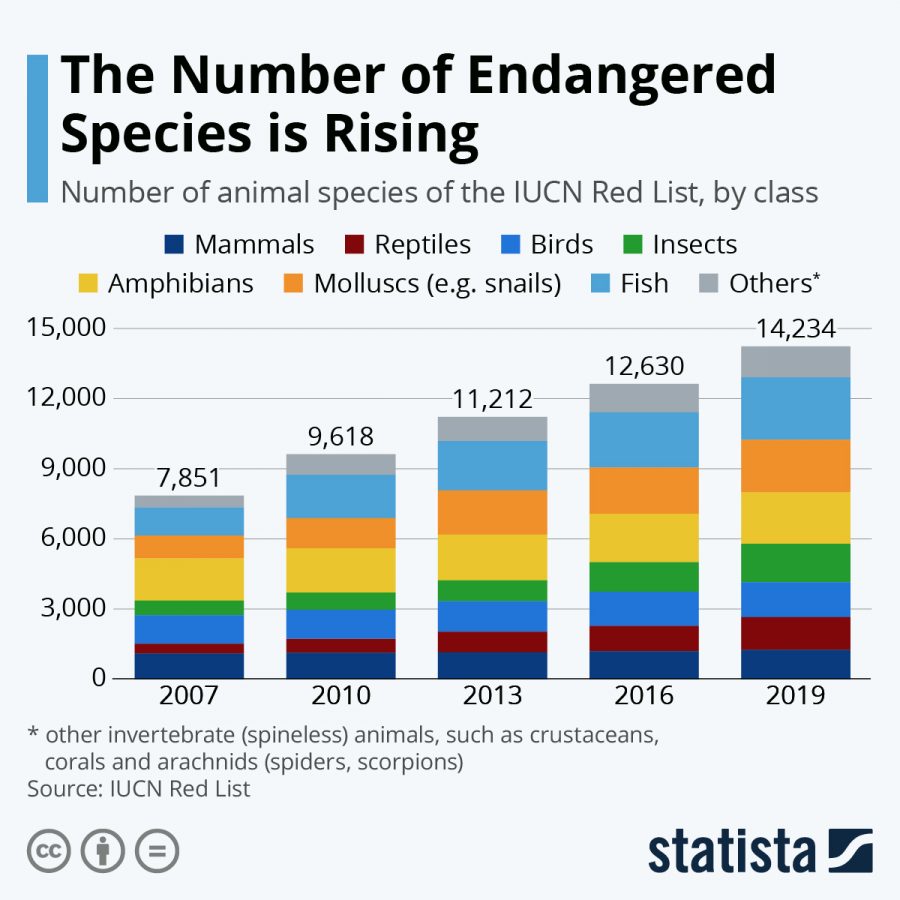Endangered Species: Controversies, Cost, and Process
Every year there are one to five species that go extinct because of humans.
https://www.statista.com/chart/17122/number-of-threatened-species-red-list/
When looking at the expenses for the Endangered Species Act, fish consume the most amount of money for endangered/threatened species.
February 4, 2021
An endangered species is a species that is going to become extinct if nothing is done to save them. The Endangered Species Act was adopted in 1973 during Nixon’s presidency. Before this act was adopted there were many other acts. In 1934 there was the Bald Eagle Protection Act, this was the beginning to many more protections for all kinds of animals. Around the Industrial Revolution it was very popular to go whaling. Whales were killed and hunted for their meat and blubber. During the time, the population was rapidly decreasing. They created the Whaling Convention Act of 1950. While many of these small acts helped, the Endangered Species Act helped even more by protecting a wide variety of animals and plants. However, getting an animal on that list is no easy task.
The process of classification of an endangered species is a long vigorous process. This process can take anywhere from one to five years. To begin an organization needs to create a petition to put their chosen species on the list. With the petition you can either list an animal as threatened/endangered or reclassify/delist it.
Once a petition has been picked it heads to the second step which is called a 90-day review. During this time NOAA decides whether to accept or deny this petition. In order to send their species to the next step there needs to be a significant amount of scientific proof that their species is going extinct. If their information is correct, then it gets put as a positive 90-day review. Subsequently, it goes to the next process which is the status review.
The status review evaluates the species status. This includes studying their biology, ecology, population trends, and their role in their ecosystem. The status review can either take a year to complete or in other cases five years. Typically, after a year the status review is complete, and NOAA goes on to validate this petition once again. If it is confirmed it will be marked as a 12-month finding/Proposed Rule. Afterwards a public hearing will be held to make comments on their information.
The last step is Final Rule where NOAA looks at the public comments, and any new information given to them from the hearing. Continuing NOAA make their final decision on if this species will be put on or taken off the list. Once it’s approved, it could take an additional year to put it on the Federal Registry.
However, there is a second way to go about this process. This second process is called Self-Initiated; it is where NOAA voluntarily choses their own species to review. It has all the same steps as having a petition but without the multiple deadlines associated with the petition process. This is able to stop the extinction rate drastically.
Once an animal is then officially classified as endangered or threatened it will be protected by The United States Endangered Species Act of 1973. The ESA (Endangered Species Act) bans the killing and the import/export of the now endangered species. If a person happens to kill an endangered species it can result in a year in prison or fines up to 50 thousand dollars. In addition, the ESA protects the land or water needed to assist in the recovery of the species. Finally, they develop recovery plans for the animal or plant.
The United States Endangered Species Act has saved the life of countless species. Some of the species that were saved were the Bald Eagle, grizzly bear, and even the humpbacked whale. However, there is a lot of controversy regarding the Endangered Species Act.
“I don’t believe it is fair to protect animals like wolves and mountain lions who come down into pastures and yards and kill livestock or terrorize neighborhoods. I do believe in poaching laws to protect endangered animals; however they are often not enforced, and therefore quite useless. If we humans took responsibility to take care of the environment around us as best we can, the world would be a different place,” a Facebook comment said.
One of the main controversies is the amount of money that has been spent into this act.
In 2017 alone there was a total of 1.28 billion dollars spent on the ESA. The top five species in 2017 ranged from 34 million dollars to 119 million. With the top 5 species added it came up to roughly 317 million dollars spent. All five of these species were all different breads of fish.
There are many ways this number could be reduced if that was the goal. There are different ways we can protect animals while still being cost effective. For example, if a structure is being built for them the materials could be supplemented for cheaper ones. In a perfect world animal would not go extinct but we do not live in that world. To help the growing extinction of animals you could sign petitions, or even become an activist. Or an even easier task is pick up trash around your community. There are many things a person could do, but that is your choice to act or not to act.




